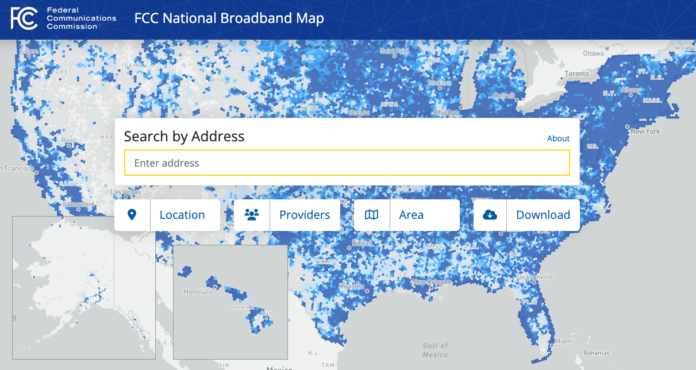The ‘pre-production draft’ map will undergo an 8-week period of challenges to its accuracy
The Federal Communications Commission has released its long-awaited new maps that lay out the extent to which broadband service options are available across the United States.
The map released online today is a “pre-production draft of [the] new National Broadband Map” and display location/address-level information about available broadband services, from wireline options to satellite and both licensed and unlicensed Fixed Wireless Access —a “significant step forward”, the FCC said, from the census-block level data that was previously used to determine the extent of broadband availability. That census-block approach meant that if even one location within a census block had broadband service, the clock was considered “served”—which in many cases masked the fact that other people living in the same census block didn’t actually have access to a broadband service.
Now comes the challenge period. Even with much-improved maps, there will inevitably be some places where providers are listed as offering service, but people living there or neighboring competitors know that they actually don’t. So consumers, industry observers and advocates, and service providers will be able to challenge the information in the maps for a period of eight weeks. The FCC said that the public challenge process “will play a critical role in improving the accuracy of the map, which is based on provider submissions and is supposed to reflect the state of deployments as of June 30, 2022.
“Today is an important milestone in our effort to help everyone, everywhere get specific
information about what broadband options are available for their homes, and pinpointing
places in the country where communities do not have the service they need,” said
FCC Chairwoman Jessica Rosenworcel. “Our pre-production draft maps are a first step in a long-term effort to continuously improve our data as consumers, providers and others share information with us. By painting a more accurate picture of where broadband is and is not, local, state, and federal partners can better work together to ensure no one is left on the wrong side of the digital divide.”
Rosenworcel tweeted this morning that the maps are “a beginning, not an endpoint, for the new era of broadband maps.”
The initial reaction from industry groups and companies seems to be largely positive, with some saying that at first blush, the new maps appear to be a vast improvement over previous attempts to map the constantly-changing state of broadband deployment in the U.S.
Subscribe now to get the daily newsletter from RCR Wireless News
A spokesperson from WISPA, which was among several groups allowed a “sneak peek” of the maps yesterday, said that “The general, initial impression that it’s an impressive leap in technology, light years beyond the 477, with the much (if not all) of the granularity we have been advocating for years. Congrats to the FCC, especially for such a quick turnaround on putting the first draft together. Our members are still going to have to kick the tires and work through the challenge processes, but that said, it’s a first good look.”
ACA Connects VP or Regulatory Affairs Mike Jacobs put up a brief video on Twitter breaking down his takeaways from the brief demonstration of the mapping tool that the FCC gave the day before release. “Number one, it’s a really cool tool,” he said. “You can search in lots of different ways” including by address, zooming in on a specific geography, or searching by service or provider. People can download the underlying data by state or provider. “For better or for worse, it’s easy to file both fabric and service accessibility challenges,” Jacobs said, adding, “The good news is that it appears to not allow challenges on the basis of actual speed falling short of advertised speed. The user is instead directed to file an informal complaint. Hopefully that will cut down on the volume of challenges filed.” He added that providers have several ways, including email alerts, to know whether their information has been challenged; they can then either concede or dispute a challenge.
The FCC has been accepting bulk challenges to the dataset from state government, service providers and others since mid-September. Now the map is also open to public, individual challenges. The deadline for challenges to the preliminary map is January 13, 2023.
Rhonda Johnson, AT&T’s EVP of federal regulatory relations, praised the FCC’s work in getting the maps out and added that “We know this is not a ‘one and done’ effort and we will continue to work with the Commission at each stage of this process to ensure the maps have the most accurate view of broadband availability.”
The maps are available at broadbandmap.fcc.gov. While the maps are focused on fixed broadband availability, the FCC noted that the draft map also allows users to view the mobile wireless coverage reported by cellular service providers.
“For years we’ve struggled to determine the exact contours of the digital divide. The FCC’s new map provides the most precise assessment to date of Internet haves and have-nots,” said Alan Davidson, assistant secretary of Commerce for communications and information and NTIA administrator, in a statement on the map release. “This map is just a first draft, so we encourage consumers, companies, and government leaders to dive into the data and give feedback to the FCC. Together, we can craft a map to guide us to our goal of connecting everyone in America.”


 Broadband consumers are empowered like never before
Broadband consumers are empowered like never before